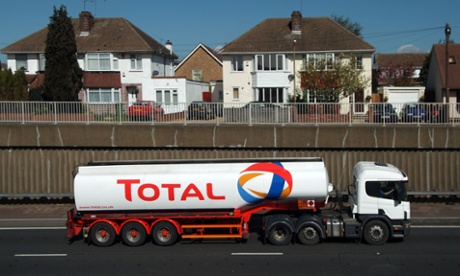
Low-carbon fuels – think biofuel, hydrogen and electricity – currently comprise a mere 3% of today’s fuel mix. That needs to increase to 35% by 2050 if irreversible climate change is to be avoided, according to the Intergovernmental Panel on Climate Change.
The business-led sustainability group BSR, a global nonprofit that counts oil giants Shell, Chevron and ENI among its more than 250 members, is trying to map how such a transition could occur. In January, the organization released its recommendations for transitioning to low-carbon, sustainable fuels in order to prevent global warming from climbing past the critical 2C mark.
With energy companies sitting on 1,688bn barrels of oil reserves from the Arctic ice caps and Canada’s tar sands, it won’t be easy to push a transition forward. But the BSR-managed Future of Fuels coalition believes it’s doable, assuming organizations take the right steps at the right time. So, what’s the plan?
1. Get the trucks in the fast lane
Medium and heavy-duty vehicles make up just one in every 14 vehicles on the road, yet they account for more than 25% of road transportation fuel, according to the National Petroleum Institute’s figures in the BSR report. Extend that to commercial vehicles of all kinds and the proportion jumps to 43%. This number isn’t shrinking: a study commissioned by Exxon predicts that commercial vehicle demand will increase by 70% between now and 2040.
The conclusion: change won’t happen without fleet operators and other major corporate fuel buyers getting onboard.
Fleet operators aren’t deaf to such numbers, says Ryan Schuchard, associate director for BSR’s climate change program. Nor are they clear what to do about them. “Fleet operators are all over the place,” says Schuchard, who blames the mess on competing messages from scientists, activists and fuel providers. “Ultimately, we need a stronger and clearer voice from the users of these fuels that [sustainability] matters.”
2. Make it viable
Despite huge advances in alternative fuels over recent years, commercial viability is still a long way off. Full commercialisation won’t just happen – it requires massive investment, both in technology and infrastructure (think national networks of electric vehicle charging points, hydrogen filling stations and so on). Governments will have to pay up, but so too will the private sector – aided, most likely, by subsidies or other policy incentives.
3. Crunch the numbers
There are many knowledge gaps in the world of low-carbon fuels. Scientists, for example, are getting close to calculating the carbon intensity of different fuel types. But finding consensus (or even data) on the water, social or economic footprints of low-carbon fuels is hard. Those studies that have been done mostly exist in isolation.
Alongside the need for hard science is the need for agreement around basic scientific parameters, Schuchard says. “There are so many different ways to think about the impacts of fuel. Direct or cumulative, probable or actual, objective or situational, chronic or acute: it’s all a bit of a hodgepodge at present. The real challenge is to put these together into a unified framework.”
4. Performance first
Proponents of various low-carbon fuels have plenty to say about why their fuel of choice is cheaper, betterand cleaner. Objective, performance-based data is what’s missing. “We need to flip from companies thinking about the type of fuel they use to the performance criteria of the fuel,” Schuchard says.
BSR hopes its proposed “fuel tool” will provide this. The tool, which is backed by Walmart, Coca Cola, UPS and PepsiCo, will aim to provide uniform lifecycle assessment information for all low-carbon fuels. It will start with carbon intensity, before expanding into other sustainability issues. A first iteration should be ready by the end of this year.
5. Everyone’s a winner
Don’t go betting on winners, BSR pleads. The last century might have been a one-horse petro-powered race, but the future is polyfuel. The rationale for a more diversified fuel mix is twofold. First, there’s the so-called “locked in” problem: what if you throw all your eggs into the liquefied natural gas basket, only to watch an as-yet-unknown wonder fuel spring up?
Second, there are unintended consequences to consider. None of the current crop of low-carbon fuels is without question marks. For natural gas, it’s methane leaks in production. For biofuels, it’s land use. For electric, it’s dirty power stations. These need to be ironed out before even thinking about which option might possibly win out.
6. Don’t dawdle
As BSR’s report makes clear, low-carbon fuel will only become a meaningful reality if systemic changes take place soon. The level of atmospheric carbon has already surpassed 400 parts per million. Exceed 450 parts per million and we’re fried. Policymakers, scientists and businesses all have a role to play in preventing that.
Furthermore, overhauling today’s fossil-fuel dependency is not a short-term game. But none of this should stop companies from acting now. Schuchard: “There are uncertainties, but not enough for us to delay.”
As a recent BSR report clarifies, there are practical steps corporate fleet operators and truck operators can take. Establishing a fuel-sustainability policy is a starter. Accelerating low-carbon solutions through collaboration is another.
As for the laggards and naysayers? Tell them to go stick it in their tailpipes.
The values-led business hub is funded by SC Johnson. All content is editorially independent except for pieces labelled “brought to you by”. Find out more here.

